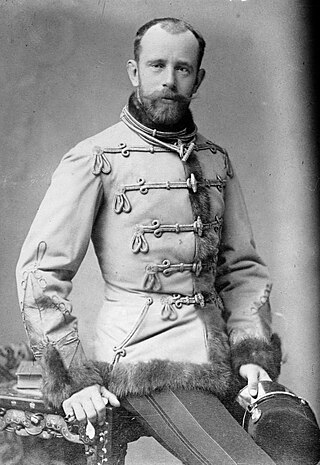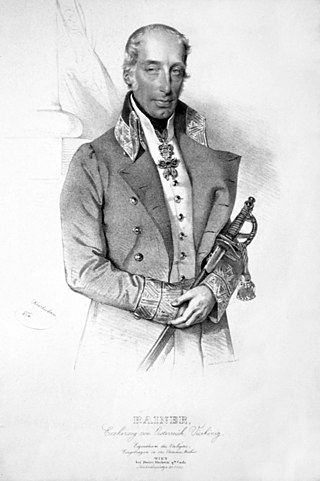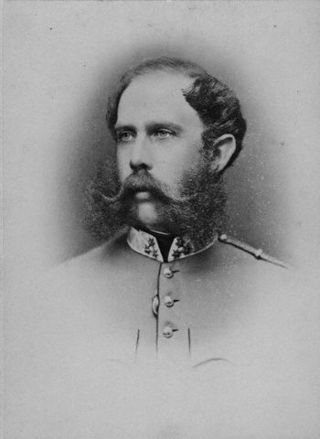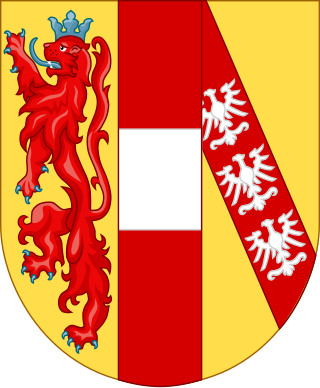Related Research Articles

The House of Habsburg, also known as the House of Austria, is one of the most prominent and important dynasties in history.

Franz Joseph I or Francis Joseph I was Emperor of Austria, King of Hungary, and the ruler of the other states of the Habsburg monarchy from 2 December 1848 until his death on 21 November 1916. In the early part of his reign, his realms and territories were referred to as the Austrian Empire, but were reconstituted as the dual monarchy of the Austro-Hungarian Empire in 1867. From 1 May 1850 to 24 August 1866, he was also president of the German Confederation.

Charles V was Holy Roman Emperor and Archduke of Austria from 1519 to 1556, King of Spain from 1516 to 1556, and Lord of the Netherlands as titular Duke of Burgundy from 1506 to 1555. He was heir to and then head of the rising House of Habsburg during the first half of the 16th century. His dominions in Europe included the Holy Roman Empire, extending from Germany to northern Italy with direct rule over the Austrian hereditary lands and the Burgundian Low Countries, and Spain with its possessions of the southern Italian kingdoms of Naples, Sicily and Sardinia. In the Americas, he oversaw both the continuation of the long-lasting Spanish colonization as well as a short-lived German colonization. The personal union of the European and American territories of Charles V was the first collection of realms labelled "the empire on which the sun never sets".

Charles I or Karl I was Emperor of Austria, King of Hungary, King of Croatia, King of Bohemia, and the last of the monarchs belonging to the House of Habsburg-Lorraine to rule over Austria-Hungary. The son of Archduke Otto of Austria and Princess Maria Josepha of Saxony, Charles became heir presumptive of Emperor Franz Joseph when his uncle Archduke Franz Ferdinand of Austria was assassinated in 1914. In 1911, he married Princess Zita of Bourbon-Parma. He is venerated in the Catholic Church, having been beatified by Pope John Paul II on 3 October 2004, and is known to the Catholic Church as Blessed Karl of Austria.

Maximilian I was an Austrian archduke who became emperor of the Second Mexican Empire from 10 April 1864 until his execution by the Mexican Republic on 19 June 1867.

A dynasty is a sequence of rulers from the same family, usually in the context of a monarchical system, but sometimes also appearing in republics. A dynasty may also be referred to as a "house", "family" or "clan", among others.

Rudolf, Crown Prince of Austria was the only son and third child of Emperor Franz Joseph I of Austria and Duchess Elisabeth of Bavaria (Sisi). He was heir apparent to the imperial throne of the Austro-Hungarian Empire from birth. In 1889, he died in a suicide pact with his mistress Mary Vetsera at the Mayerling hunting lodge. The ensuing scandal made international headlines.

The Habsburg monarchy, also known as Habsburg Empire, was the collection of empires, kingdoms, duchies, counties and other polities that were ruled by the House of Habsburg and, following the partition of the dynasty, especially by its Austrian branch. From the 18th century it is also referred to as the Danubian monarchy or the Austrian monarchy.
Sir William Hartley Hume Shawcross is a British journalist, writer, and broadcaster. He is the incumbent Commissioner for Public Appointments. From 2012 to 2018 he chaired the Charity Commission for England and Wales.

Archduke Rainer of Austria was a Viceroy of the Kingdom of Lombardy-Venetia from 1818 to 1848. He was also an Archduke of Austria, Prince Royal of Hungary and Bohemia.

José Fernando Ramírez was a distinguished Mexican historian of the 19th century. He was a mentor of Alfredo Chavero, who considered him "the foremost of our historians." A moderate liberal republican, Ramírez opposed the French invasion of Mexico and establishment of monarchy in 1862, but accepted the position of Minister of Foreign Affairs in the regime of Emperor Maximilian I of Mexico. He was a valuable asset for the emperor, who wished to have a broad appeal to Mexicans.

Archduke Leopold Maria of Austria, Prince of Tuscany was the second son of Archduke Leopold Salvator, Prince of Tuscany and Infanta Blanca of Spain. At the fall of Habsburg monarchy he remained in Austria and recognized the new republic in order to marry Dagmar, Baroness von Nicolics-Podrinska. The couple had one daughter. After divorcing his wife in 1931, Leopold eventually emigrated to the United States where he became a naturalized American citizen under the name Leopold Lorraine, and where he remarried. He died in 1958 in Connecticut.

Archduke Karl Ludwig Josef Maria of Austria was the younger brother of both Franz Joseph I of Austria and Maximilian I of Mexico, and the father of Archduke Franz Ferdinand of Austria (1863–1914), whose assassination ignited World War I. His grandson was the last emperor of Austria, Charles I.

The House of Habsburg-Lorraine originated from the marriage in 1736 of Francis III, Duke of Lorraine and Bar, and Maria Theresa of Austria, later successively Queen of Bohemia, Queen of Hungary, Queen of Croatia and Archduchess of Austria. Its members are the legitimate surviving line of both the House of Habsburg and the House of Lorraine and inherit their patrimonial possessions and vocation to the Empire from their female line of the House of Habsburg and from the male line of the House of Lorraine.

Archduke Ludwig Viktor Joseph Anton of Austria was the youngest child of Archduke Franz Karl of Austria and his wife Princess Sophie of Bavaria, and as such was the younger brother of Emperor Franz Joseph I. He had a military career, as was usual for archdukes, but did not take part in politics. He was openly homosexual and declined to marry princesses who were sought for him. He is well-known for his art collection and patronage as well as philanthropy.
Martyn Rady is Masaryk Professor Emeritus of Central European History at the School of Slavonic and East European Studies (SSEES), University College London (UCL). He was from 1995 to 2009 Warden of Hughes Parry Hall, an intercollegiate hall of the University of London. He retired from UCL in December 2020. He lives in Stroud in Gloucestershire.

The Order of Saint Stephen was an order of chivalry founded in 1764 by Maria Theresa. In 1938, Miklós Horthy took the rights and activities of Grand Master as Regent of Hungary. The name of the Order changed to the Royal Hungarian Order of Saint Stephen. The Order was terminated at the time of the proclamation of the Second Hungarian Republic in 1946. It was recreated in 2011 as the Hungarian Order of Saint Stephen, and to this day remains the highest order in Hungary.

Archduke Felix of Austria was the last-surviving child of Charles I, the last Emperor of Austria, and a member of the House of Habsburg-Lorraine. He was a younger brother of former Crown Prince Otto of Austria, who predeceased Felix by two months.

Archduchess Renate of Austria was a daughter of Archduke Charles Stephen of Austria and a first cousin of King Alphonso XIII of Spain. A member of the Teschen branch of the House of Habsburg-Lorraine and an Archduchess of Austria and Princess of Bohemia, Hungary, and Tuscany by birth, she renounced her titles in 1909 upon her marriage to Prince Jerome Radziwiłł.

The Execution of Emperor Maximilian is a series of paintings by Édouard Manet from 1867 to 1869, depicting the execution by firing squad of Emperor Maximilian I of the short-lived Second Mexican Empire. Manet produced three large oil paintings, a smaller oil sketch and a lithograph of the same subject. All five works were brought together for an exhibition in London and Mannheim in 1992–1993 and at the Museum of Modern Art in New York in 2006.
References
- ↑ Woodall, Tim. "Edward Shawcross". Faber. Retrieved 2023-02-15.
- ↑ "Edward Shawcross: In Conversation". Get History. Retrieved 2023-02-15.
- ↑ Lay, Paul. "The Last Emperor of Mexico by Edward Shawcross review — history as both tragedy and farce". The Times . ISSN 0140-0460 . Retrieved 2023-02-15.
- ↑ Amazon Reviews of the Last Emperor of Mexico. 20 January 2022. ASIN 0571360572.
- ↑ "The Times Best History Books 2022". The Times . November 2022.
- ↑ Shawcross, Edward. The Last Emperor of Mexico: The Dramatic Story of the Habsburg Archduke Who Created a Kingdom in the New World. New York: Basic Books, 2021 ISBN 978-1541-674196
- ↑ Shawcross, Edward. The Last Emperor of Mexico: A Disaster in the New World. London: Faber & Faber, 2022